Portulaca (also called Rose Moss or Moss Rose) is an annual that thrives on neglect yet blooms non-stop Summer into Fall. Learn how to grow these pretty flowers easily. Perfect in hanging baskets and in the garden!
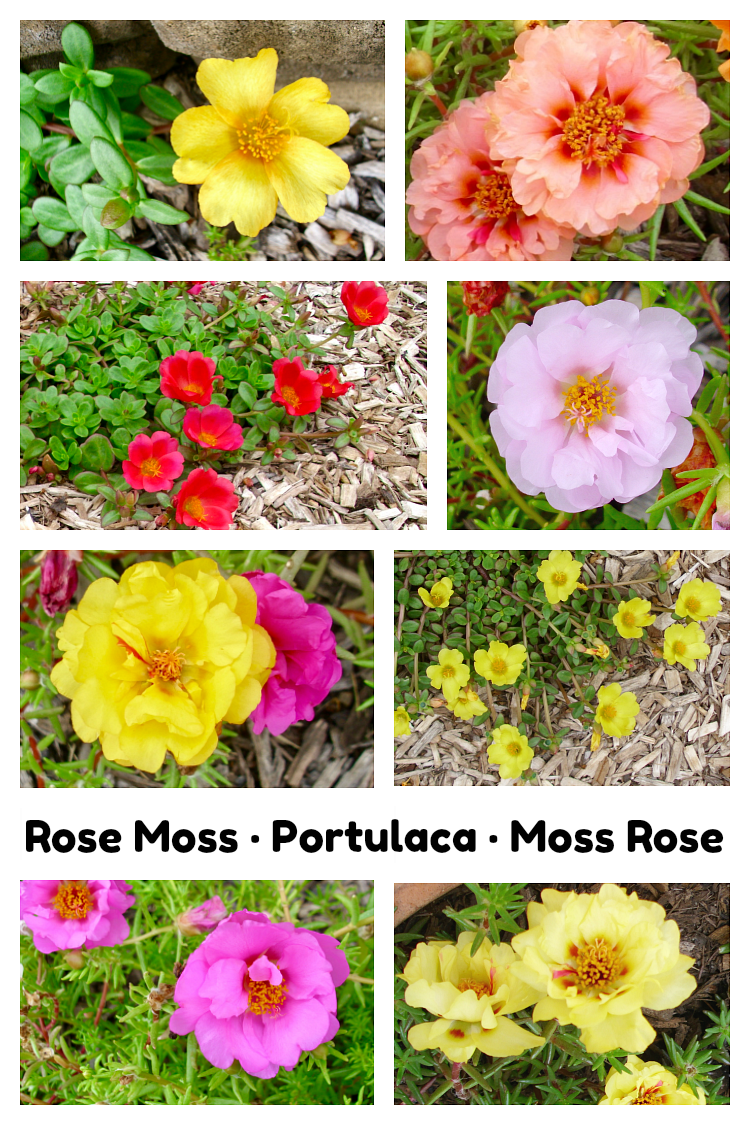
If the idea of watering your garden often is not your cup of tea, you should consider drought-tolerant plants.
I’m not just talking about plants that can withstand a week without rain. I’m also thinking that “drought” means nobody remembered to water the plants for a day or so…or three.
Ask the staff at your local nursery or home improvement garden center for drought tolerant plants – that’s the usual lingo used. One favorite usually mentioned is Portulaca and here’s why . . .
Table of Contents
Portulaca, Moss Rose, Rose Moss
My all-time favorite plant that absolutely thrives on almost total neglect is the annual flower Portulaca.
Portulaca also goes by the names moss rose, rose moss and sometimes purslane, although many times purslane refers to the wild “weed” version of portulaca.
I remember first seeing Portulaca in my grandmother’s garden when I was a little girl, and have loved it ever since.
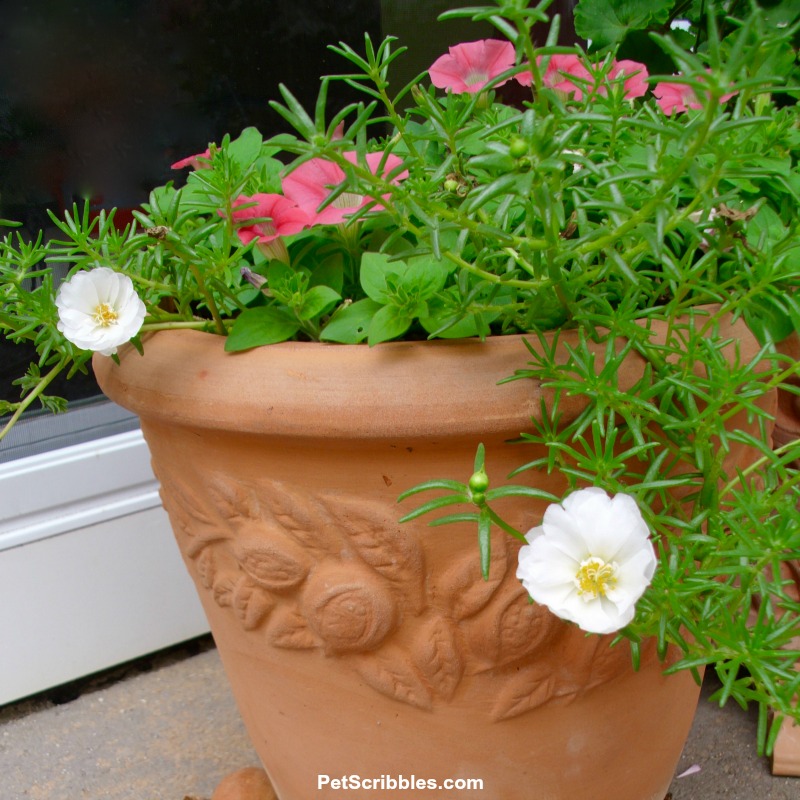
I plant this every year in my garden and containers.
Why do I love Portulaca so much?
- Blooms all Summer into Fall (as long as there is warm sunshine)
- Spreads with more and more blooms as the Summer progresses
- Thrives in poorer soils
- Doesn’t need fertilizer
- Not bothered by any serious pests
Helpful tip: Portulaca is the perfect choice for rock gardens, hot and dry spots, hanging baskets and containers. It thrives on neglect, and you’ll look like a professional gardener as the plants keep on blooming all Summer long into the Fall season!
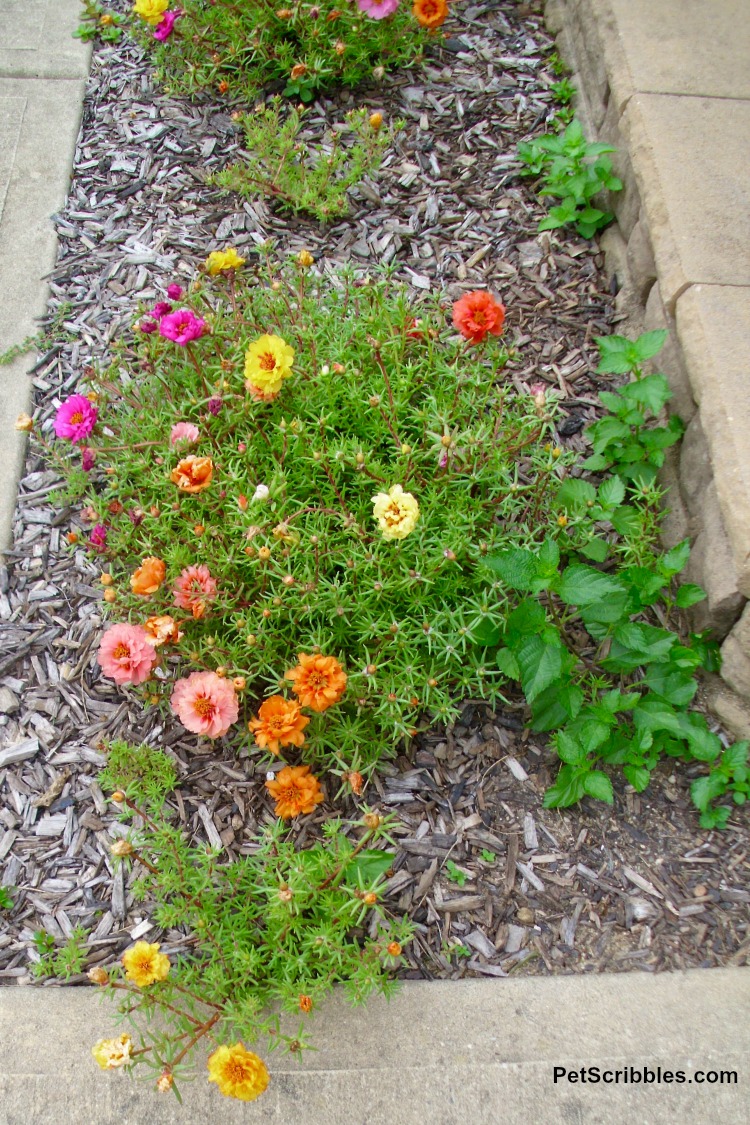
Portulaca Growing Requirements
And you can’t get much easier than a plant that thrives on neglect!
- Sun: full sun
- Portulaca flowers don’t open in shade or on cloudy days
- The flowers also close at night
- Water: drought tolerant but does best with periodic water
- too much water can drown the roots and kill the plant
- Hardiness: USDA zones 5 to 11, although Portulaca self-seeds nicely
- Soil: average, well-drained soil
- Spread: each plant spreads between 12 and 24 inches
- Bloom time: Long-blooming all Summer into Fall, depending on your climate
- Fertilize: not necessary, as it thrives in poor soil
Let me repeat: no need to fertilize this plant at all. In fact, if you do fertilize it? You might kill it. Seriously.
OK, didn’t mean to scare you, but a little fertilizer will encourage more green leaves than blooms. A lot of fertilizer will indeed kill the plants.
Important: As with many garden plants like azaleas, daylilies and begonias just to name a few, portulaca can be toxic to dogs and cats if swallowed. Please research your plants for toxicity if you have furry family members who enjoy being outside with you. The ASPCA has a great list here.
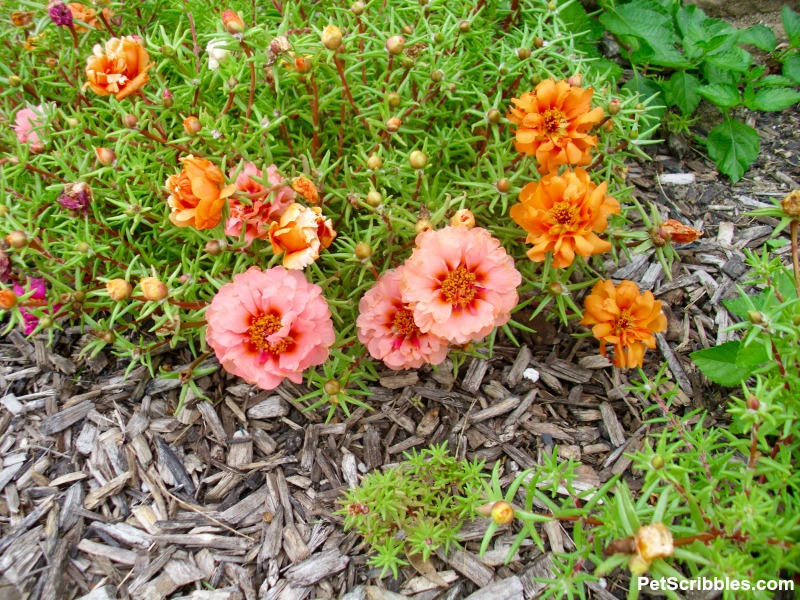
Chipmunks Love Portulaca
Yes, chipmunks love to munch on portulaca. Having watched them one too many times, my guess is portulaca must be equivalent to whatever our own favorite foods are.
The way the chipmunks go up to the plants, grab a flower or flowerbud stem in their greedy little paws, then munch away while their eyes close in complete bliss . . .
OK, I made up the last part, but they might as well be enjoying a tub of mint chocolate chip ice cream.
Repel the Chipmunks!
I love Bonide products, as they’ve worked well for me. You can use either granules, which are spread around the plants in a container or garden bed. Or you can use a spray which works the same way to repel the critters and won’t harm your plants.
These two products work well:
Bonide Animal Repellent, Ready-to-Use Spray
While the product “title” says it’s for deer and rabbits, it also repels several other unwanted critters including pesky chipmunks.
Bonide Repels-All Animal Repellent Granules
Similar to the spray mentioned above, this product says it’s for deer and rabbits, but it also repels many unwanted visitors including chipmunks. I use this mainly for rabbits, and whenever I see chipmunks around.
Portulaca Flowers Are Single and Double Blooms
There are so many varieties of Portulaca to choose from!
The blooms are either single-flower blooms or double-flower blooms, depending upon the variety.
Both single- and double-flower portulaca plants are commonly found at garden centers and nurseries, and are also easy to grow from seed.
Both types come in a gorgeous array of Summer colors — including white, pinks, reds, yellows, and oranges — in both primary colors and pastels.
There are even some newer double-flower hybrids that have multiple colors on one plant!
Also be on the lookout for special double-flower varieties with veining on the flower petals, such as the Peppermint Portulaca varieties like this one:
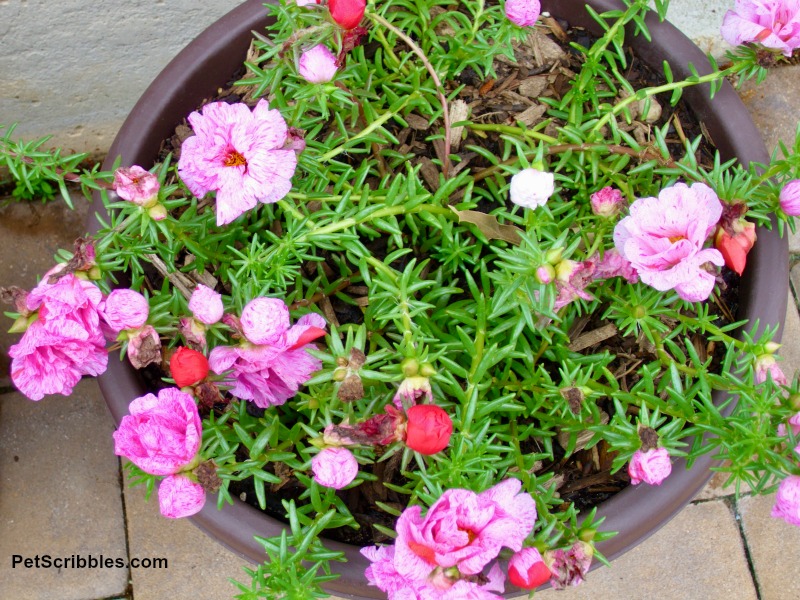
Important little fact: Portulaca will close up during rain or on cloudy days, and sometimes at night too. This occurs more with the single-flower version than it does with the double-flower version.
Single Flowers
The single-version portulaca plant is more of a groundcover, growing out (horizontally) rather than up (vertically). The height is a mere few inches, but the spread can be easily 14 inches or more.
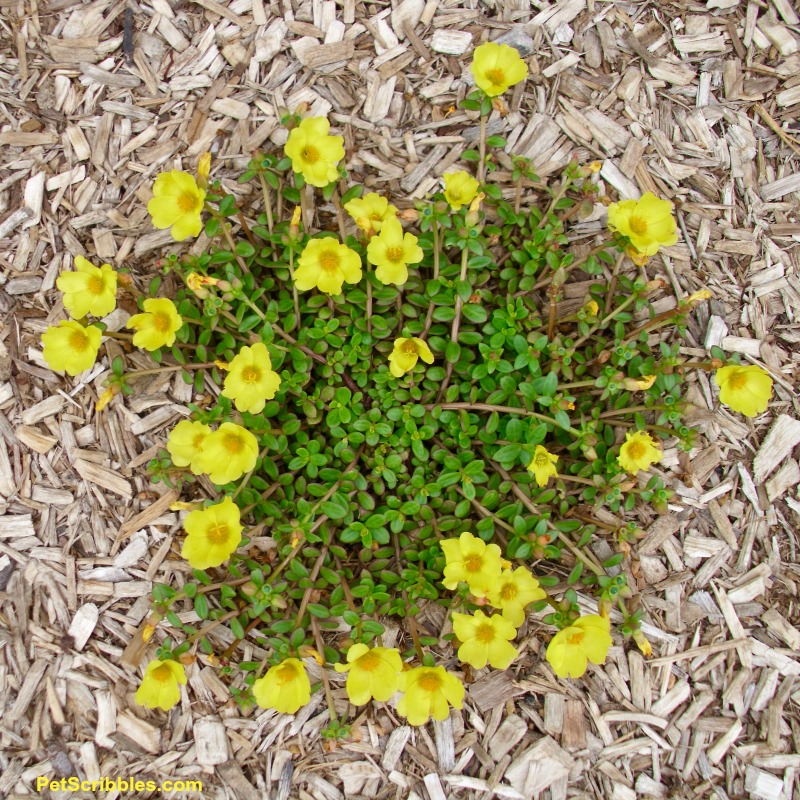
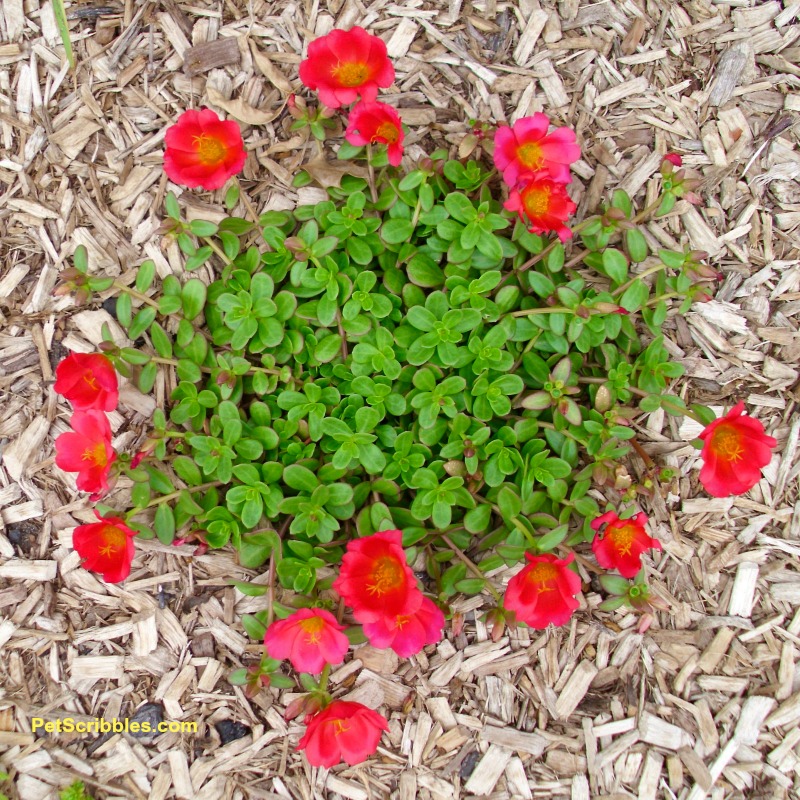
Double Flowers
The double-version (sometimes called semi-double) portulaca grows a bit more vertically, and the flowers resemble tiny roses with their frilly double petals.
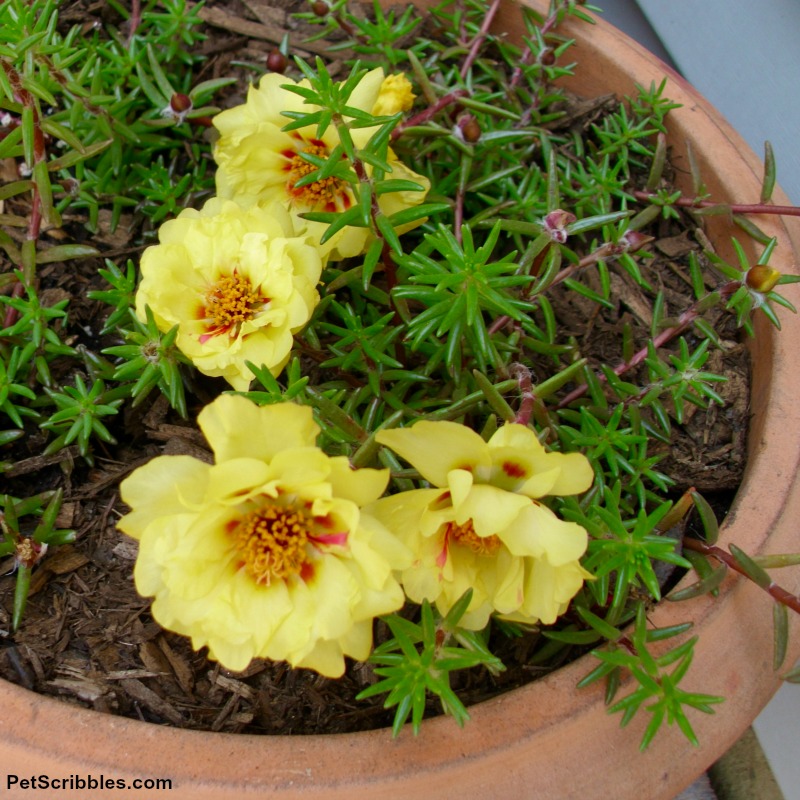
There are so many beautiful shades of double-flowered portulaca! Here are just a few to whet your appetite . . .
Pretty Pastels!
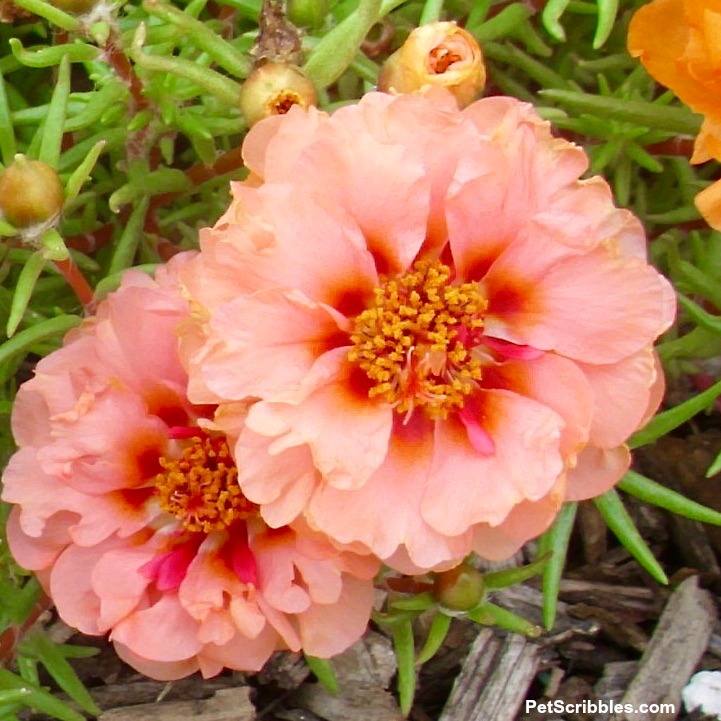
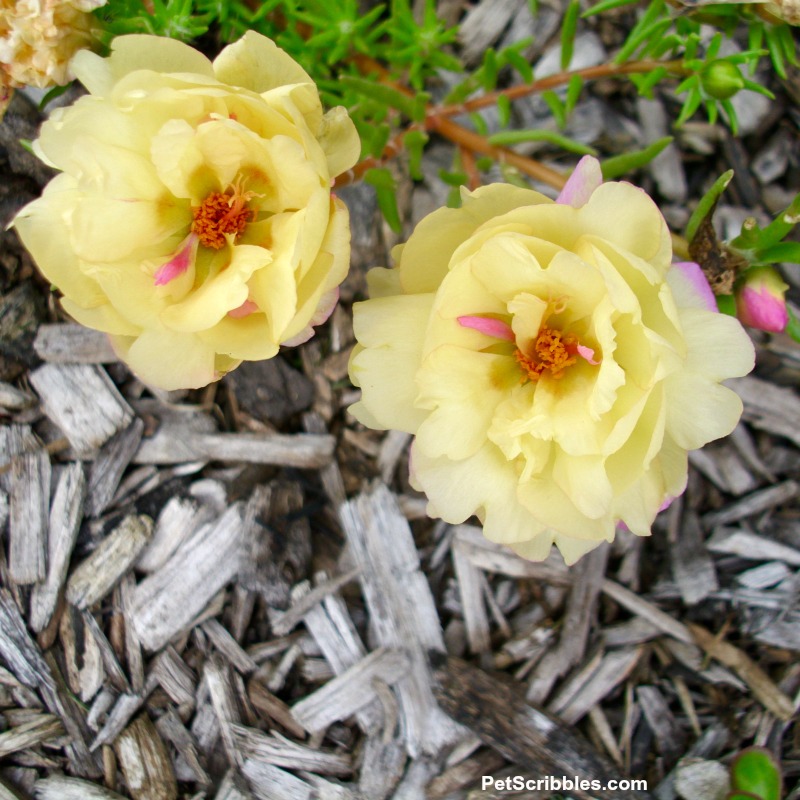
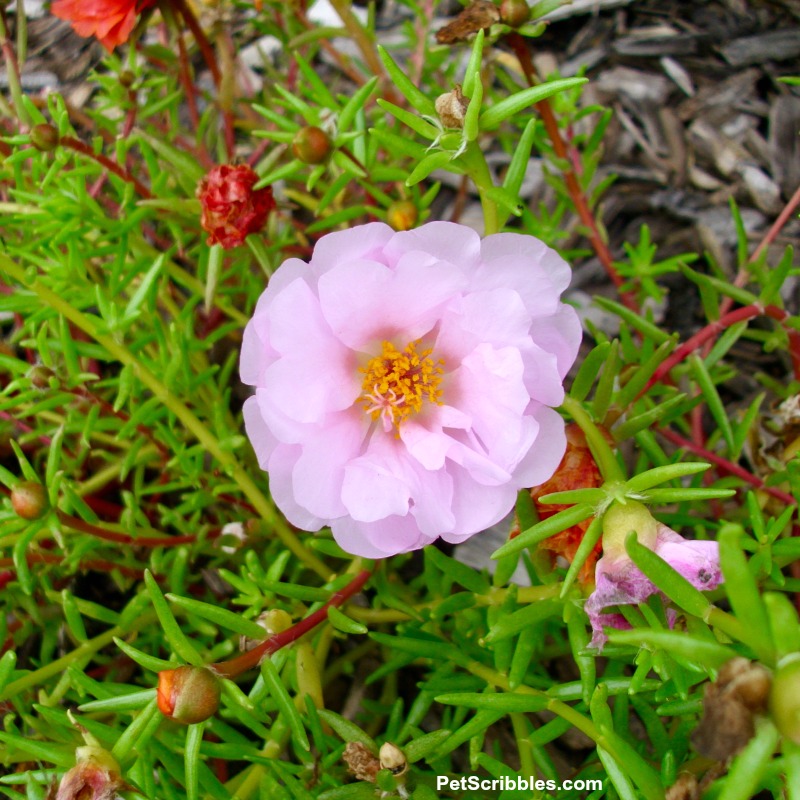
Bright Colors!
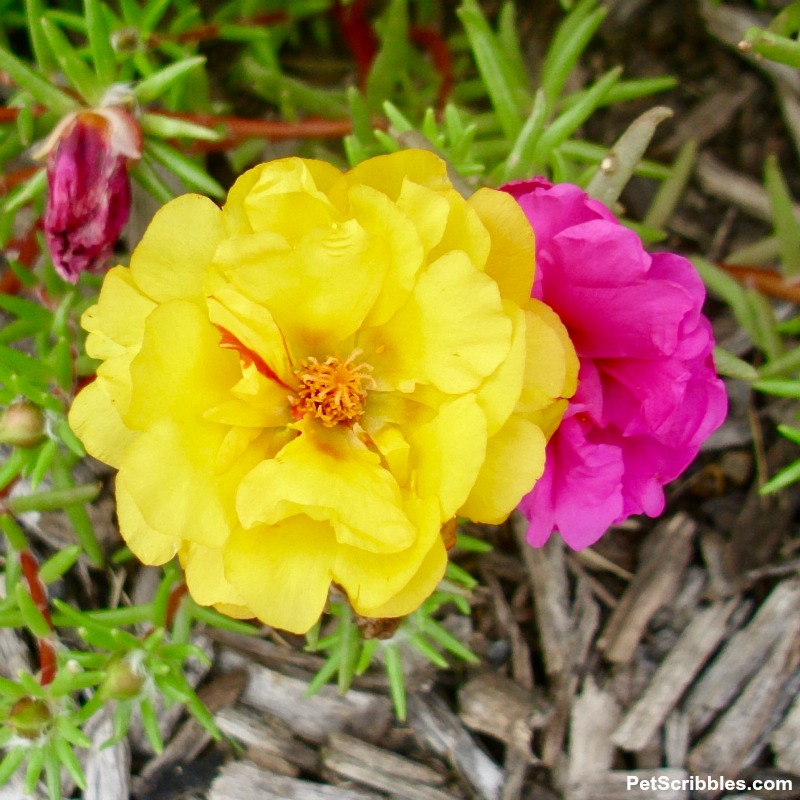
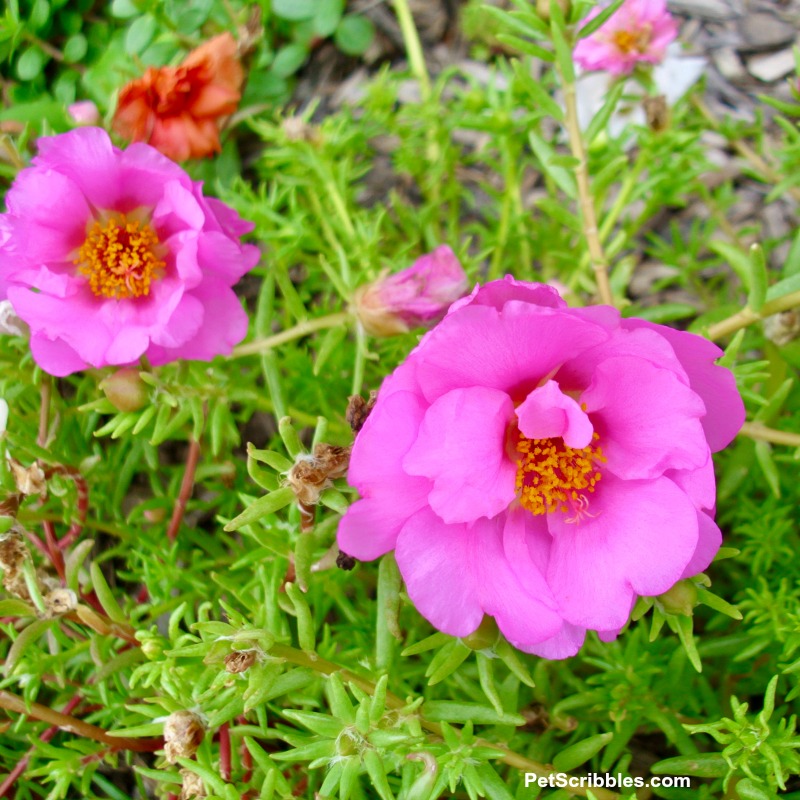

Should you plant single or double varieties?
Try both!
Annual… but sort of a perennial too!
Another great thing about Portulaca is that it nicely reseeds itself, but not invasively.
For example, in the photo below, you can see our single-flowered red Portulaca I planted in June with some of the double-flowered seedlings that sprouted up from the previous year’s planting. We love this!
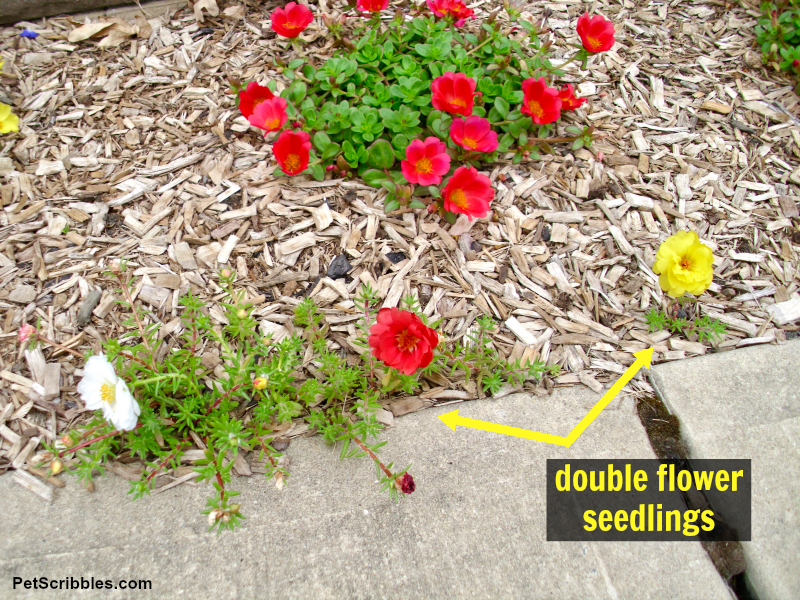
Spot the Seedlings!
It is easy to spot newly sprouted seedlings for two reasons.
First, seedlings don’t begin to sprout until mid-June, so you can happily weed away in the Spring without worrying that you might be pulling up any valuable new plants.
Secondly, when the seedlings do show up, you can tell them apart from other weeds right away because their tiny leaves immediately resemble their full-grown versions.
Single Flower Portulaca Seedlings
The single-flower varieties of portulaca have very different leaves than the double-flower ones.
These leaves truly look like succulent leaves:

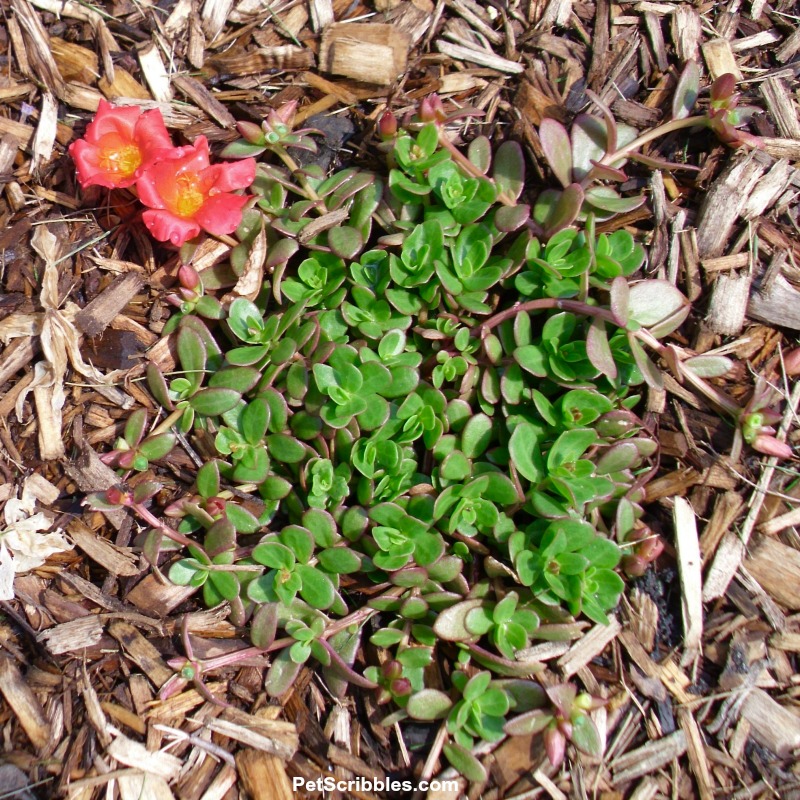
Double Flower Portulaca Seedlings
The double-flower seedlings are noticeable for the needle-like leaves, and that they begin blooming while the seedlings are still very small:

Single Flower Portulaca in our Garden
Garden Update: We redid our landscaping, removing the grass in the front yard and turning it into several garden beds. While I no longer have the gardens shown below, I still grow Portulaca in containers and love it! -Laura
We have a strip of garden in front of our low-walled garden beds that gets super-hot in the Summer, next to our sidewalk.
Portulaca has been the perfect solution for this spot.
Below is a photo of newly planted portulaca. You can barely see it. It looks like flat green blotches in the mulch.
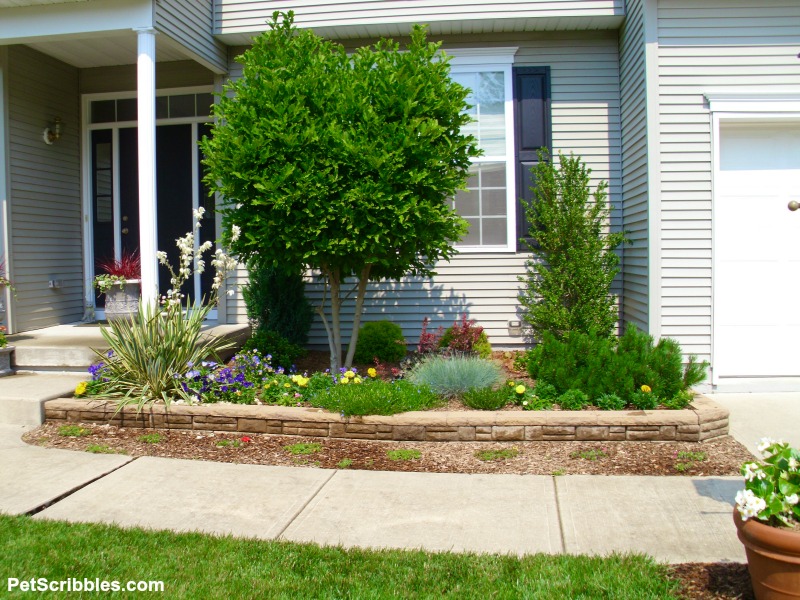
Just one month later, most of them are blooming, plus other seedlings from the previous year have appeared.
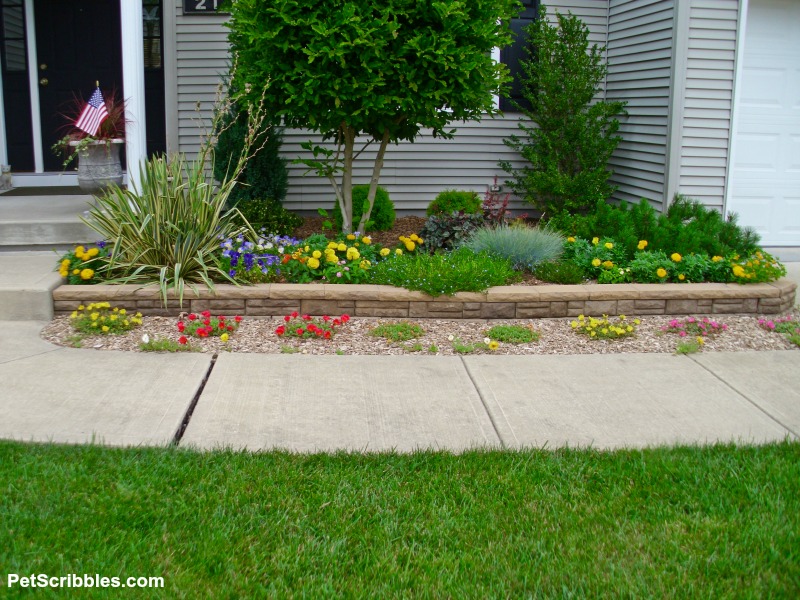
A closer look at the single-flower portulaca planted in front of the low garden wall. All of the double-flowered seedlings popping up against the sidewalk are double-flower varieties.

Watering tip: The plants receive water whenever we run our lawn sprinklers or when it rains. Portulaca is a succulent, which means that it stores water in its leaves and stems to use when it gets a bit thirsty. Because portulaca’s root system is very shallow, too much water could actually drown the roots thus killing the plant.
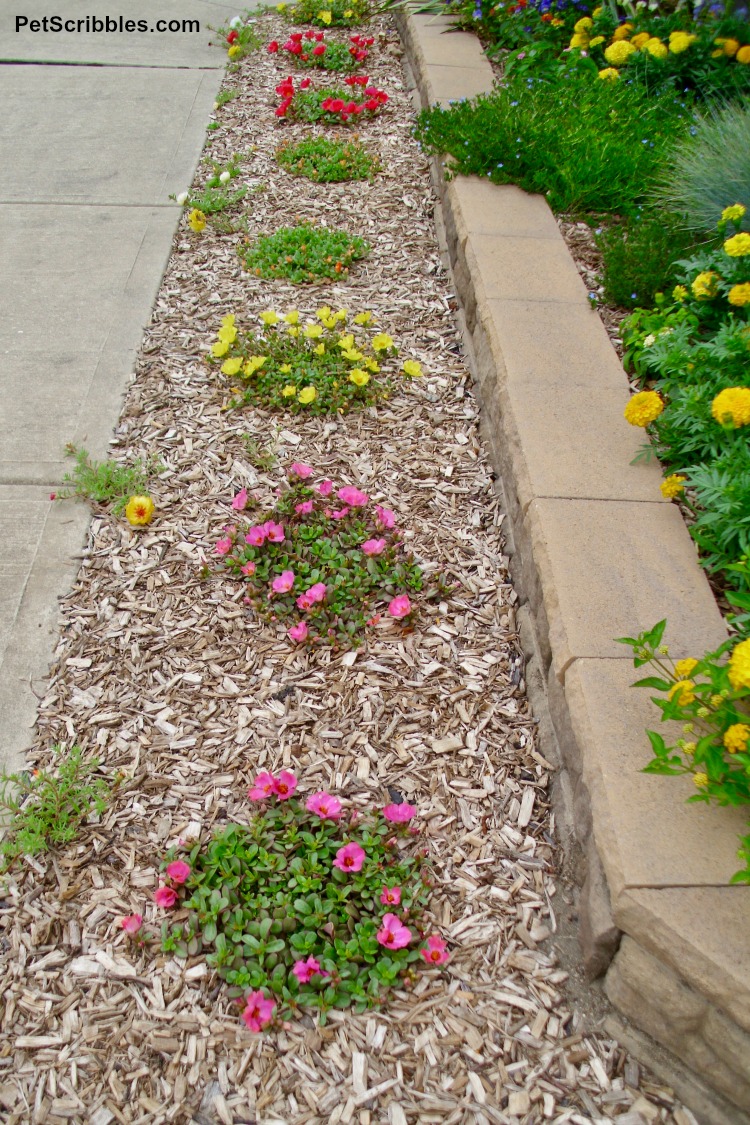
Double Flower Portulaca in our Garden
The following year, I decided to plant double-flower Portulaca in this same garden strip.
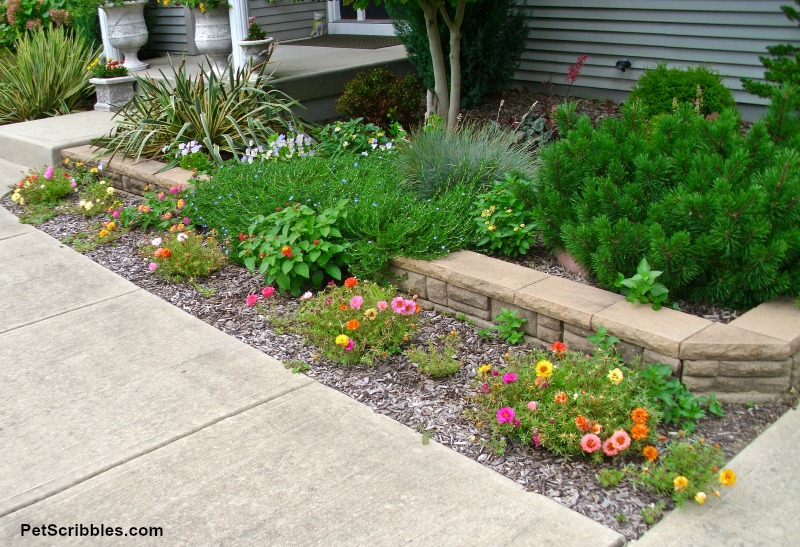


I also potted up a bunch too, as they are fabulous in containers — especially as they can handle drought. These containers moved all over the backyard patio throughout the Summer wherever I wanted more color.

Single-flower varieties popped up from the previous year’s dropped seeds all around the double-flower plants!

I planted Lantana Landmark Sunrise Rose (below) in a few places just to help fill in any planting gaps between the Portulaca plants. The colors of the Lantana and the Portulaca match perfectly!

Taking a few steps backwards, below is a photo of the plants behind the Lantana and Portulaca. In the back, from the left: Yucca, Pansies, and the bushy plant with a few blue flowers is Lithodora. Behind the Lithodora: more Lantana, Heuchera and Elijah Blue Fescue grass.

So what do you think?
Do you like the bold colors of the single-flower varieties? Or do you prefer the frilly double-flower varieties?
Either way, you can’t go wrong!
Happy gardening!

The birds are eating the leaves on my portulaca hanging baskets. I’ve tried putting plastic snakes in the baskets, but the birds just sit on the snakes while they munch! Do you have any suggestions? My plants look terrible.
Hi Dot, I wish I did have a good suggestion for you. The problem with birds, is once they’ve settled on a hanging basket — whether it’s too pick at the plant or to begin making a nest in the basket — it seems like there’s nothing we can do. Many gardeners have tried many things to make the birds go away, including putting bits of Irish Spring soap into their planters, or using some tulle netting placed over the top part of the basket that can’t be seen depending on how high the basket is hanging. The problem with any of these possible “solutions” is what you pointed out: the birds aren’t phased by anything. And trying plastic snakes is one of the best ideas too! I wish I had a solution to offer, but the only thing I can think of is to turn your hanging basket into a planter and place it near your front door or back door — somewhere near where people go in and out. Perhaps if the basket is down low, and the “hanging” part of the basket is removed, the birds won’t spend time there. I wish I had the perfect solution for you!
I’ve sprinkled cayenne pepper on the plant and that seems to have helped. Downside is I have to reapply after rain. I love your idea of changing it into a planter. Thanks for getting back with me!
How do I keep the chipmunks away. I just planted Portulaca and I’m stressed bc I don’t want them eaten. Thanks.
Hi Jan — good question, as chipmunks love portulaca! I just updated my article above, and include links to two products that work for me — both by Bonide. I’ve used the granules for rabbits and have seen they work for chipmunks as well whenever they pop up into the garden. I hope these can work for you as well. These products won’t harm the Portulaca either, which is perfect! I hope this helps!
I’m in Atlanta, Ga. I didn’t get the name of the product. Could pls send me the names again?thnx
Hi Jan, if you scroll up back to the top of the article, you’ll find the Table of Contents. Scroll down to #4 and click on “Chipmunks Love Portulaca and How to Repel Them” and that will take you directly to the section that lists the two products — both by Bonide — that work to repel critters. I hope this helps you!
I’ve found with most of my flowers that garlic powder dissuades the pests pretty well. I used to keep a giant container around as the smell wears off after a few weeks. I tried planting garlic in front of all my gardens but it didn’t help.
That’s a fantastic tip, Carol! The Bonide Animal Granules I use to repel critters has garlic in it, so maybe I just need to try again! Of course I could also plant it in containers up higher than the critters can jump or climb too. This plant is so pretty!